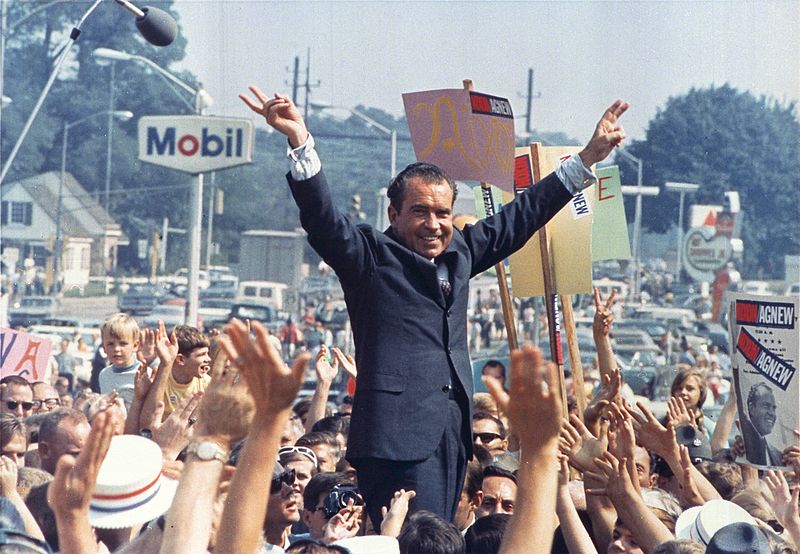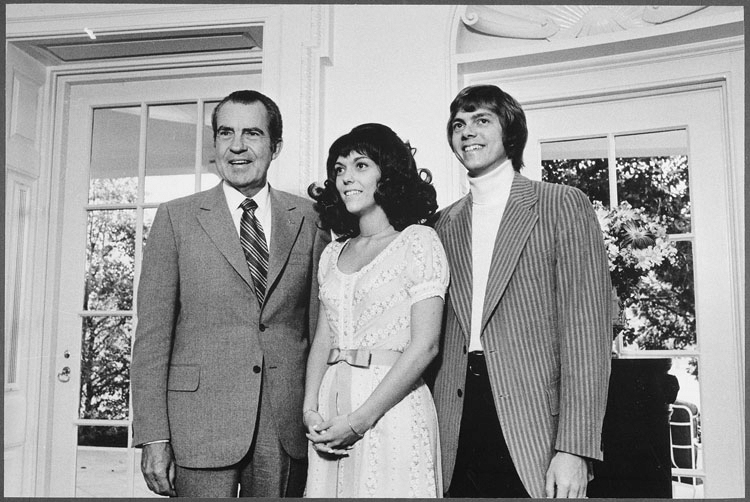 4 Columns
4 Columns
4Columns will be back with a new issue on September 6. This week we present our fourth summer missive, inspired by the end of Richard Nixon’s scandalous presidency on August 9, 1974.

Richard Nixon in Paoli, Pennsylvania. Photo: Ollie Atkins.
With each day of this summer—or, really, each day since January 20, 2017—bringing fresh horrors from the Oval Office, Richard Nixon’s resignation painfully reminds us of our ardent, if seemingly futile, wish for the current ignominious occupant of 1600 Pennsylvania Avenue to do the same. In addition to that fantasy, Nixon’s infamous departure, forty-five years ago today via helicopter from the south lawn of the White House, gives us occasion to reflect on portrayals of power.

Christian Bale as Dick Cheney in Vice. Photo: Matt Kennedy / Annapurna Pictures. © 2018 Annapurna Pictures, LLC. All rights reserved.
Unsurprisingly, some of the most nefarious Republicans of the past fifty years worked for the Nixon administration. They include Dick Cheney, who is played by Christian Bale in Adam McKay’s burlesque biopic Vice, reviewed for 4Columns by Nick Pinkerton. Noting that Vice is “intended to pack a propagandistic, propulsive force,” Pinkerton writes that McKay could be considered an adequate polemicist, one convinced that “very simple cause-and-effect explanations exist behind the expert language of government.” But the filmmaker “is hobbled as an artist by the fact that the same simplicity—simplemindedness, even—governs his dramaturgy and depiction of human relations.”

Julia Louis-Dreyfus as Selina Meyer in Veep. Photo: Lacey Terrell.
Much richer—and funnier—in its depiction of the venality and villainy of those who hold, or are running, for public office is the HBO satire Veep, whose seventh, and final, season was hailed by Catherine Damman. Julia Louis-Dreyfus stars as Selina Meyer, the erstwhile number-two official who mounts yet another bid for the presidency; Damman writes that the actress “is superlative in her physical command, careening wildly between Selina’s private grimaces and her public-facing chirps of asinine pleasantries.” The show itself, “as in much of the best comedy . . . operates by sly substitution. It promised a dick joke, a punchline about ineffectuality, a woman outside the party, uninvited. Instead, it gave the story of power’s incapacity to see itself.”

Richard Nixon with Karen and Richard Carpenter at the White House, August 1, 1972.
Blinded, deranged by ambition, Nixon was also incapable of seeing. Was everyone associated with him, no matter how remotely, tainted? Perhaps we can spare Karen Carpenter, who, with her brother, Richard, paid three visits to the White House during Tricky Dick’s years as prez. Praising Karen Tongson’s monograph Why Karen Carpenter Matters, Megan Milks recaps the author’s main argument about the singer, who died in 1983: “Karen has lived on . . . through an unlikely diaspora encompassing Filipinos and Filipino Americans, people of color, immigrants, queer and gender-nonconforming people, pretty much ‘everyone other than the white Nixon-era suburbanites she and her music are said to have represented.’ ” We might say, then, that Karen Carpenter’s soft rock—once besmirched by its affiliation with the thirty-seventh POTUS—can today be appreciated as a soft, benevolent power under the forty-fifth.